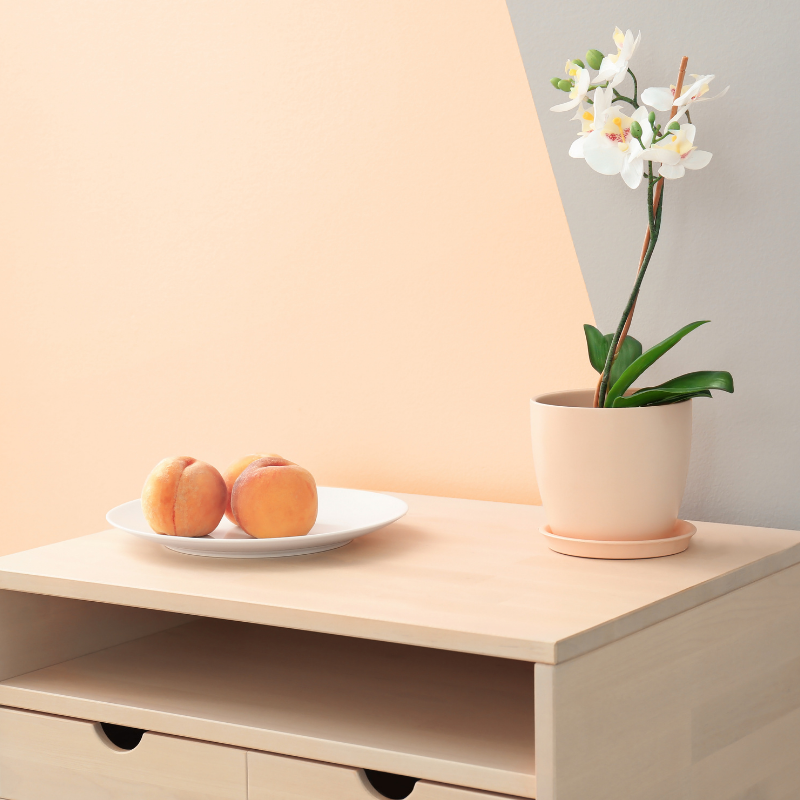
Peach is a popular colour for interiors, a versatile, soft muted shade that adds a welcome pop of colour and warmth to a space. It's not the easiest colour to blend with your existing interiors, and definitely needs some working in to ensure this colour flows throughout your interiors harmoniously.
We explore what colours go with peach, and complement each other well in your interiors.
Peach & Grey
As demonstrated above, peach and grey complement each other well, whether that's a pale grey or something more like charcoal for high contrast and visual effect.
They reflect elegance and bring a contemporary look into an interior. Try adding a third colour such as white to help balance the space. These colours are perfect for any room in the house, especially living rooms and bedrooms for a calming effect.
Peach & White
When used in collaboration, these two colours create a soothing effect in the home. Use white as the main foundation colour and incorporate peach as an accent colour. In a bedroom, weave peach in through bedding, throws and pillows. You might want to add a third colour into the mix as another accent colour to create further depth. This could be done with gold for a luxe look, or even with forest green.
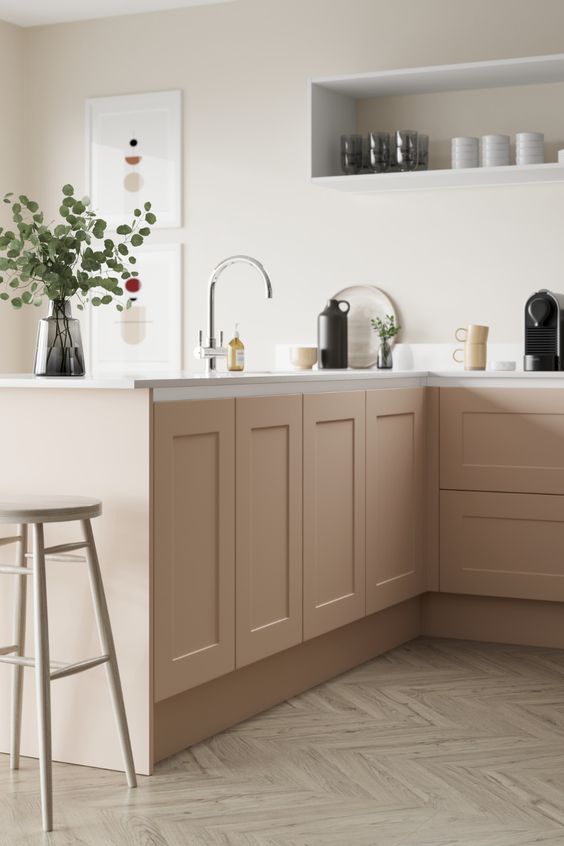
Peach & Gold
This pairing of colours is a very classic colour combination, commonly seen throughout interiors and wedding themes. The gold elements instantly add that luxe, and sophistication to the peach. This will add a rich feel to any room, don't be overbearing with the use and have small doses of each colour running throughout. Brushed Brass is a fabulous choice for sockets and switches in a peach interior.
Peach & Green
Forest green is at the other end of the spectrum from light to dark, but opposites to attract, and these two colours work perfectly together. The darker green accent contrasts perfectly with peach. Don't think about conventional interior purchases to bring green in, introduce greenery and plants for a welcome pop of this colour without it being obtrusive in the space.
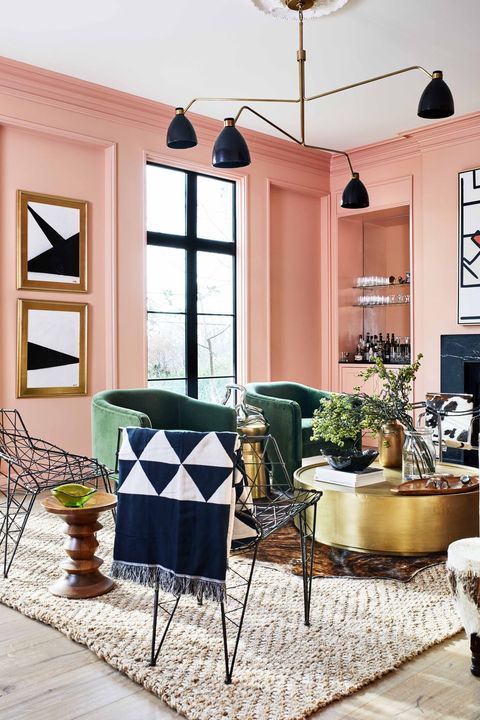
Peach & Black
These two colours can work incredibly effectively together when they are both used as accent colours in the room, especially against a white or cream backdrop. In a child's bedroom, black could be used for wall decals and frames, whilst peach could be introduced with lamp shades, and other pieces of furniture. The result is a cool colour combination which does work well in a child's nursery for a fresh look.
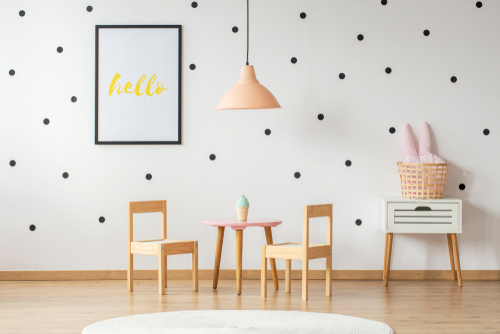
Peach & Blue
We're not talking about baby blue, although those two colours do work together well in a nursery, or child's bedroom. For a mature stance, combine cobalt blue and peach for a highly luxurious feel. A great pairing of colours for a living space or bedroom.
Peach brings a soothing effect to any interior and it complements many different shades from light to dark. A versatile colour that isn't just destined for a child's bedroom.
[related_products is_auto_added="1"]Peach is a popular colour for interiors. We explore what colours go with peach, and complement each other well in your home.
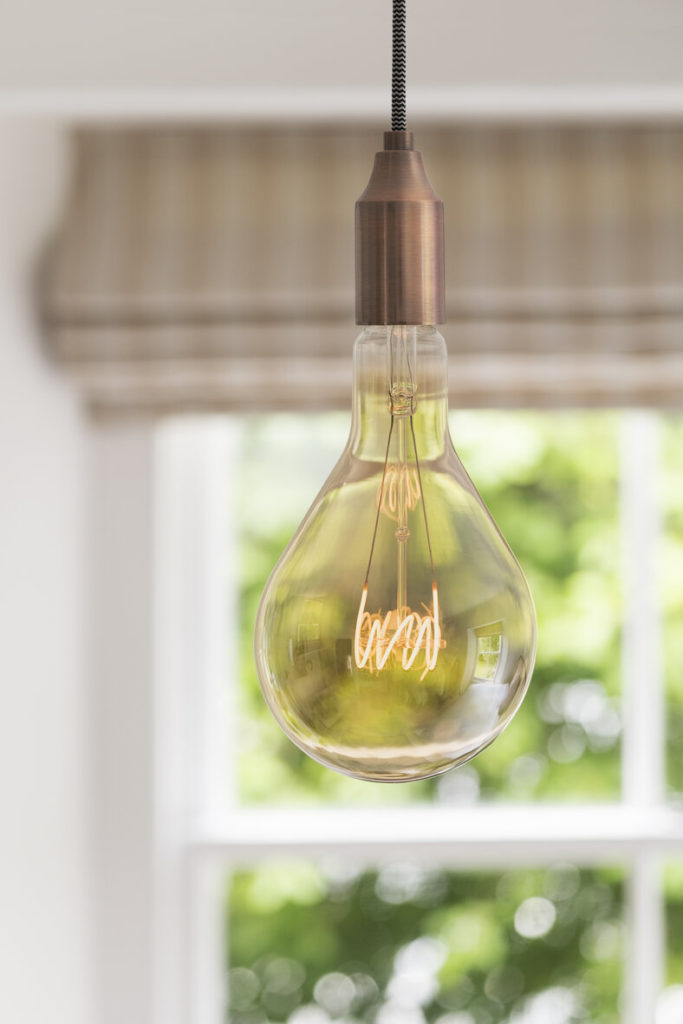
Choosing the right light bulbs for your fittings is integral to getting the most out of the fixture. Whilst also enhancing and helping to guide your interiors from room to room.
There's more to a bulb than just 'how bright it is'. We have considered lumens vs lux before as important indicators in choosing bulbs, but what about kelvins?
Kelvins are one of the most important vitals of a bulb that tell us what type of light, and ambience the bulb will create. We take a look at both kelvins and lumens of light bulbs and how to compare the two.
What Are Kelvins?
Kelvins are the unit of measurement for colour temperature. Colour temperature is the way to describe the appearance of the light which is emitted by the bulb. It might also be used as a way to ascertain what ambience is created by that level of light. Kelvins or (K) or measured from 1,000 to 10,000.
Choosing the right colour temperature is paramount to ensuring you achieve the desired level of lighting and ambience for your home. Each colour temperature has an effect on the colour of the light, and ambience it creates.
Below you can see the 3 different colour temperatures demonstrated, their kelvin measurement, their colour temperature and the atmosphere it creates.
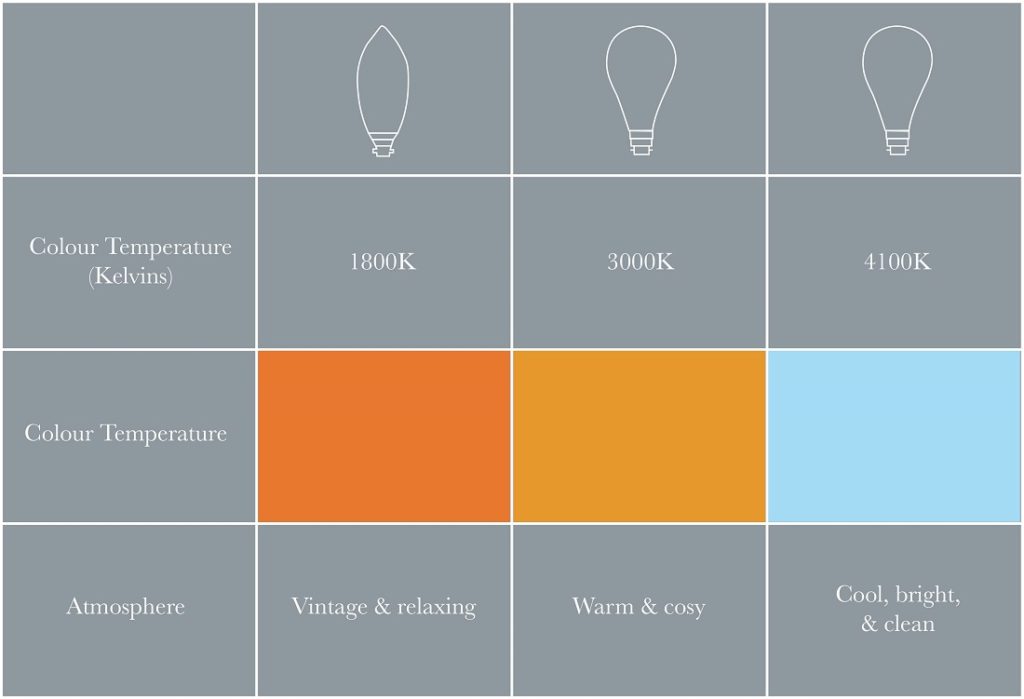
What Are The Different Colour Temperatures (kelvins)?
1800K - at the lowest end of the spectrum 1800k creates a very warm and orangey colour temperature. Perfect for creating a vintage and relaxing ambience. Warm light bulbs are best suited to living rooms or rooms designed for relaxation.
3000k - For a warm and cosy atmosphere, 3000k is the perfect colour temperature for you. Warm white bulbs cover between 2000K - 3000K and have a warm inviting glow, suitable for bedrooms, bathrooms, dining rooms and living rooms.
4100k - this is the closest colour temperature to daylight. Cool white bulbs range from 3100 - 4500K and give off a bluey whiter, brighter light. Suitable for situations and places in which good visibility is needed. It works well in the kitchen, as you'll be able to clearly see the colour of your food. It's also great for garages and workspaces too.
What Are Lumens?
Lumens are arguably one of the most important measurements to look for when choosing light bulbs. They measure the amount of light emitted by the bulb. In simpler terms, how bright the light bulb is going to be.
The higher the lumens, the brighter the light is going to be. The chart below demonstrates the colour a light will emit in comparison to its lumen rating.
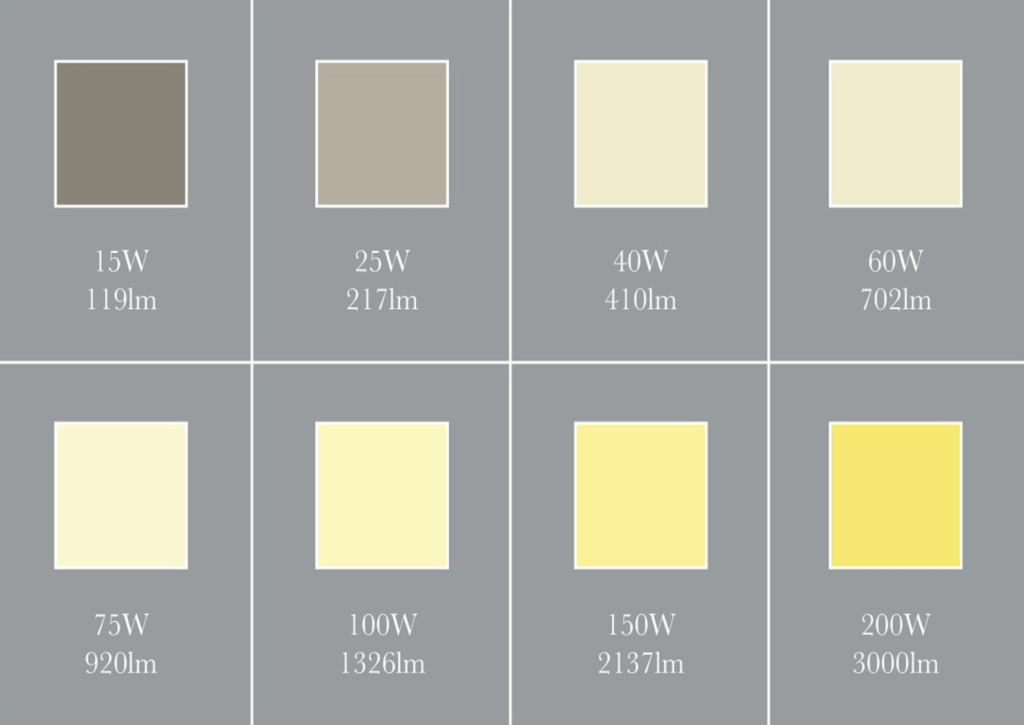
Kelvins vs Lumens
When it comes to kelvins and lumens they are both incredibly important measurements which should be considered before choosing bulbs.
Kelvins help us to understand and pick the right type of colour lighting for our home, whereas the lumens tell us how bright the light being emitted is going to be.
Lumens help us to work out how many light bulbs will be needed to adequately light a room, based on the amount of light each bulb emits. There are many calculations that can be done to work this out. This is really important if you are planning your lighting design from scratch.
Use both kelvins and lumens when you are next choosing your bulbs to help create the desired amount of light and ambience in your room. This information is readily available on the packaging of bulbs for your perusal.
[related_products is_auto_added="1"]Kelvins are one of the most important vitals of a bulb that tell us what type of light, and ambience the bulb will create. We take a look at both kelvins & lumens and how to compare the two.
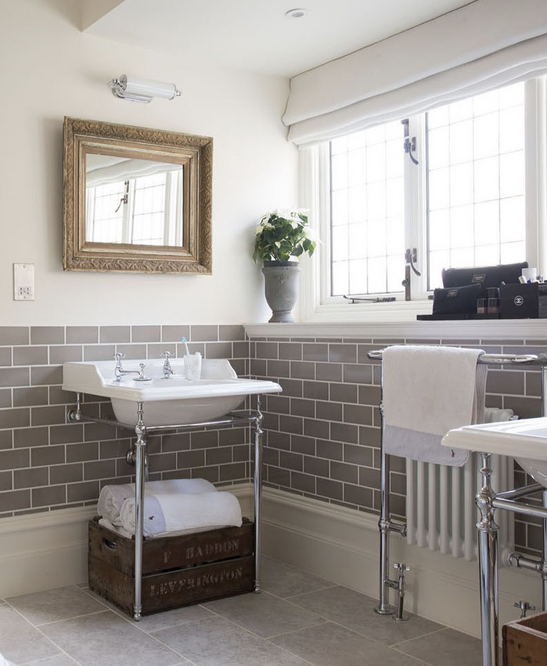
Unlike other rooms in a house, electrical products and lighting in a bathroom hold specific regulations that must be adhered to for your safety. Light switches should never be installed in a bathroom unless they are operated on a pull cord. Whilst lighting must be suitably IP rated, there is one electrical socket that doesn't carry the same rules.
Shaver sockets are regularly seen throughout bathrooms, and you've probably wondered at some point, is this even safe? And how is it that this socket is allowed, but others aren't? We explore this exception to the rule and the recommended locations of shaver sockets in a bathroom.
Can You Put A Shaver Socket In A Bathroom?
Electrical shaver sockets can be placed in a bathroom. But they do need to follow certain rules for it to adhere to regulations. Generally speaking, the only type of shaver socket allowed in a bathroom is the type with a transformer. But there are certain exceptions to this.
When choosing a shaver socket, always look for British Standard BS3535 mark to ensure it is suitable for use in the bathroom. This is the specification for industrial and domestic safety isolating transformers).
Low voltage shaver sockets should only be used in a bathroom. In accordance with the updated 17th edition of the IEE Wiring Regulations, it is safe to install electric shaver sockets in your bathroom providing the socket is 110v and installed in zone 2 or beyond. Never use a socket that exceeds 240v anywhere in your bathroom, the higher voltage puts you at risk of electrocuting yourself.
Recommended Locations In Bathroom For Shaver Socket
Electrical shaver sockets must always be within a safe distance from the sink, bath or shower to avoid splashes. They must be located more than 3m from the edge of a bath or shower. A popular location for a shaver socket is near a sink, windowsill or shelf, where it can easily be charged between uses.
With certain exceptions, a shaver supply unit complying with BS EN 61558-2-5 may be installed in zone 2 of a location containing a bath or shower (Regulation 701.512.3 refers). But they must still not be fitted any closer than 600mm from the bath or shower.
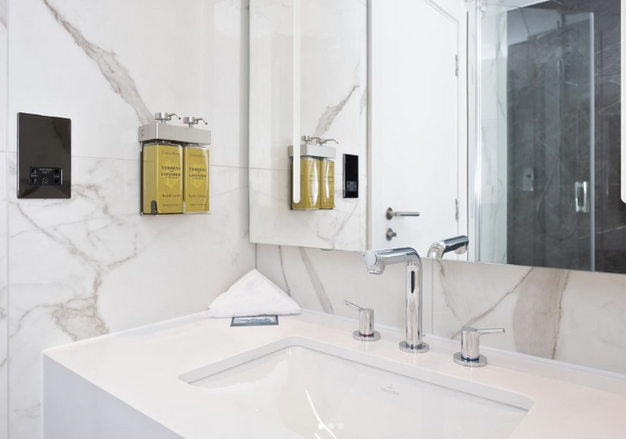
Can A Shaver Socket Charge A Toothbrush?
If the shaver socket is a 2 pin reversible plug then you can charge a toothbrush directly with the socket. If it is a 3 pin shaver socket then you will need a relevant adaptor for the socket.
Shaver sockets are not as common a feature in bathrooms as they used to be. But for ease and convenience they can still hold a place in the bathroom. Just ensure you check all manufacturing information before purchasing to ensure they adhere to the up to date safety regulations.
[related_products is_auto_added="1"]Whilst lighting must be suitably IP rated, shaver sockets do not carry the same rules. We look at the reasons why and explore some of the recommended locations.
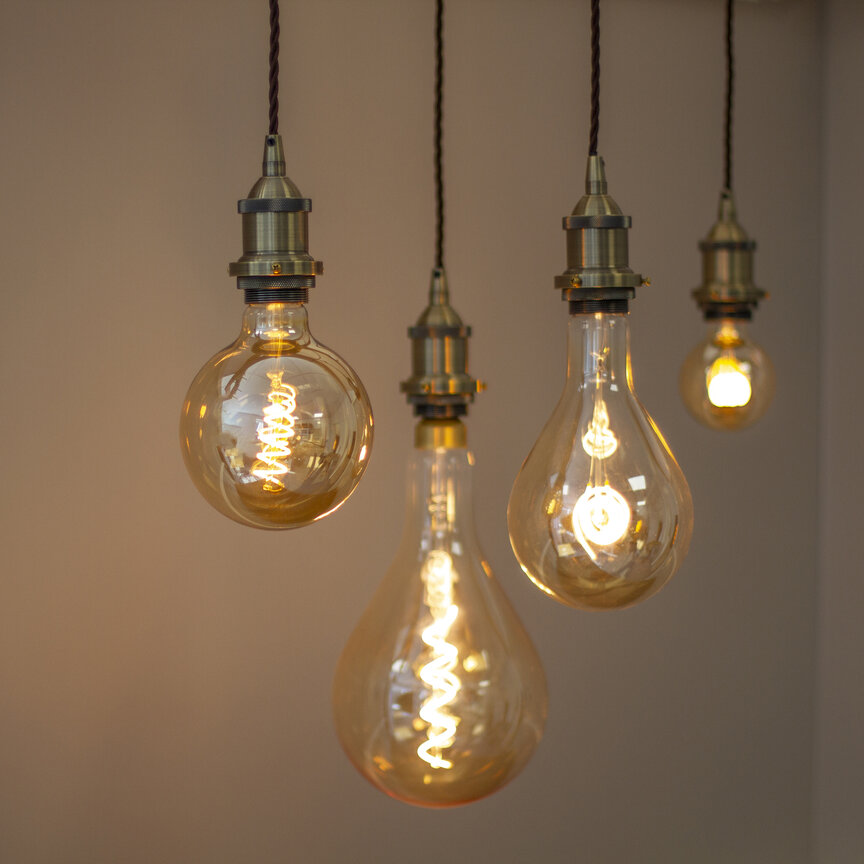
When choosing bulbs, one of the most common drivers of your purchase might be how they look aesthetically, and how bright the light is. But really, there are many more important considerations to make when choosing the right lightbulb that go deeper than the aesthetic face value.
We've previously explored lumens and watts on our blog, but what about lux? It's one of the most overlooked features of a bulb, but one that should still be considered, we take a look at lumens and lux, and what the main differences of the two are.
Lumens VS Lux
What Are Lumens?
Lumens are one of the most important indicators to look for in a light bulb. They measure the total amount of light emitted by the bulb, in simpler terms, how bright the light bulb is going to be. The higher the lumens, the brighter the light is going to be. The chart below demonstrates light output in comparison to its lumen rating.
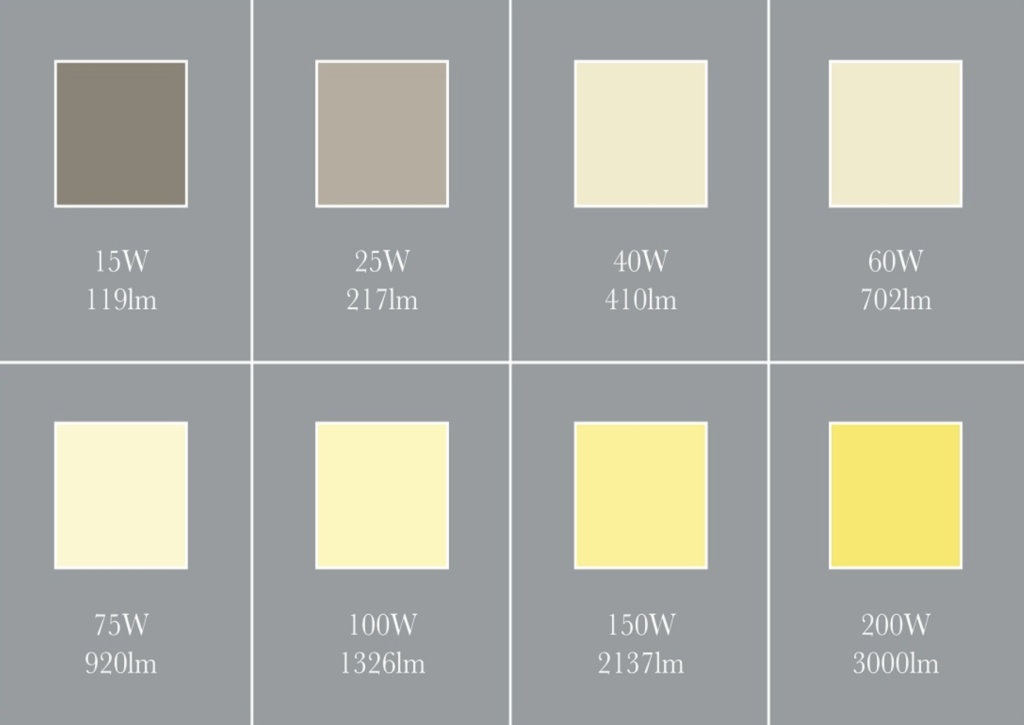
Light colour temperature is unrelated to lumens and lux, however. If you would like to read more about colour temperature, visit our blog What is Colour Temperature? for more information.
What Is Lux?
Lux measures the amount of light output in a singular area. It can be the result of multiple light bulbs and even daylight mixed in. In comparison to lumens, one lux is equal to one lumen per square meter. This figure allows us to measure the total amount of visible light which is present, and the intensity of the light on a surface. This will give you an indication of what direction the light source shines. For example, with a lamp, lux is usually indicated in the centre of the beam where the intensity of the light is highest.
The Difference Between Lumens & Lux
In layman's terms, the main difference between these two figures is that lumens is a measurement of how bright a light is going to be, whilst lux tells us where that amount of light output is going to be in a specific area.
Lux is a measure of illuminance, the total amount of light that lands on a surface. It takes into account the area over which the luminous flux (lumens) is spread. A flux of 1000 lumens, concentrated into an area of one square metre, lights up that square metre with an illuminance of 1000 Lux.
Lumens is a measure of luminous flux, the total amount of light emitted in all directions.
Which Should I Use?
You might be thinking, but which one should I be using when looking for new light bulbs? If you are looking to light a specific area such as a tabletop, work surface or for reading then the figure you need to pay attention to is lux. Without a sufficient lux level the area that you need the most light in will suffer.
However, lumens is still one you should pay attention to as you want to know how much light one lightbulb will emit. When planning your lighting setup, this is important for working out how many light bulbs you might need to adequately light a room.
Both of these figures are important to help create a well informed purchase, and to get the most out of your lighting. Lumens and Lux are both readily available pieces of information which should be visible on the packaging of most bulbs.
If you'd like to know more, check out our blog What is Lux Level? for more information on lux levels.
[related_products is_auto_added="1"]We take a look at lumens and lux of light bulbs, what these two features mean, and which one you should look for when buying bulbs.
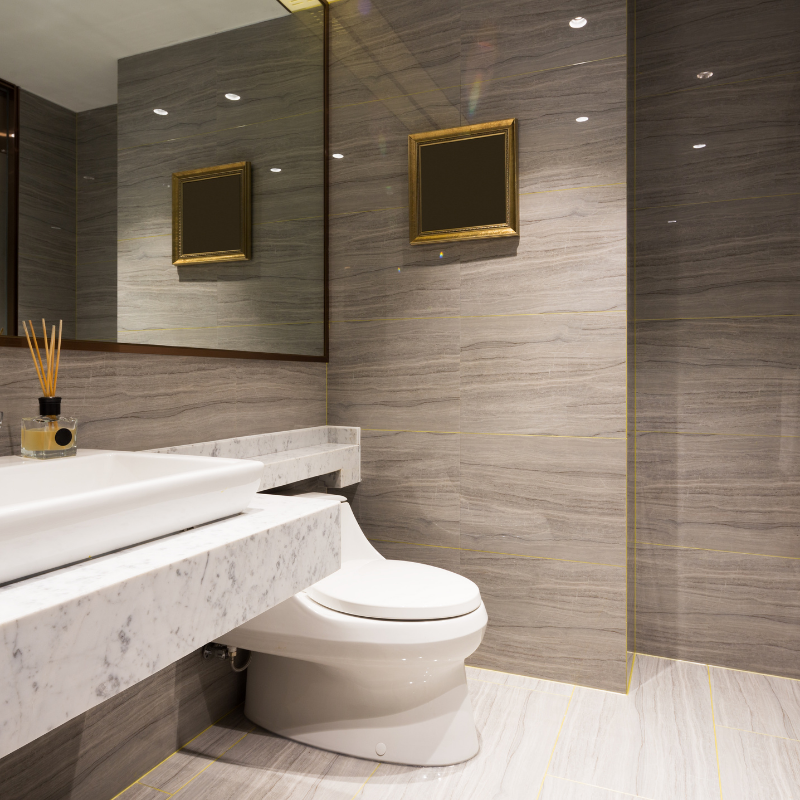
The lighting scheme in your bathroom is one of the most important rooms to get right. It requires flexibility and control over your lighting, whilst the lighting in a bathroom must comply with zonal regulations for safety reasons.
Downlights are one of the most popular, and common choices for lighting a bathroom. Distributing even lighting and adding flexibility with dimmable downlights, and a dimmer. But with certain zones in a bathroom, is it safe to use them? We explore using downlights in your bathroom, and what precautions you need to take.
Can Downlights Be Used In A Bathroom?
Downlights are in fact one of the best types of lighting for a bathroom, but you need to ensure that they carry the correct IP rating. This rating is the protection level against potential dirt and moisture.
The bathroom is split into 3 different zones, as demonstrated below which help you to understand what IP rating is needed for each zone. But, what exactly do they mean?
Zone 0
This is inside the bath or the shower itself. Any fitting here must be low voltage (max 12v) and be rated at least IP67 (total immersion proof). This is the highest IP rated downlights possible, although you generally wouldn't light this zone in a bathroom.
Zone 1
This is the area above the shower or bath, to a height of 2.25m from the floor. Here the minimum rating required is IP46, but it is generally better to go higher - to IP65. This will enable you to match all downlights throughout the room.
Zone 2
This is the area 0.6m outside of the perimeter of the bath and up to 2.25m from the floor. An IP rating of at least IP44 is required here. It is also good to consider the area around a sink, within a 60cm of any tap to be considered as zone 2.
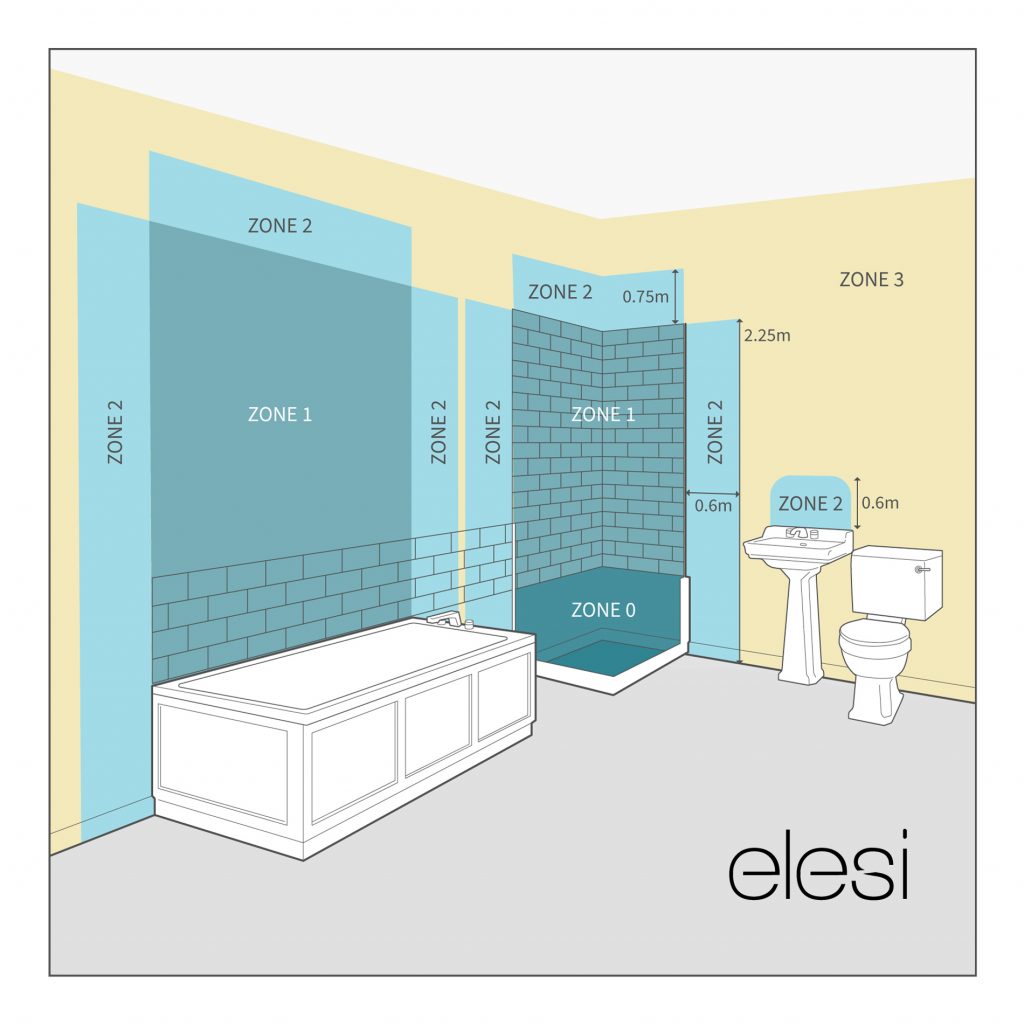
Whilst IP44 downlights are appropriate for zone 2 in a bathroom, it is generally best practice to go higher and use IP65 + rated downlights throughout a bathroom for maximum protection, and also so they match throughout.
In zone 0 downlights need to carry an IP rating of 67+, although it is unlikely you would choose to light such an area so low down.
Dimmable Downlights In A Bathroom
As long as they are suitably IP rated for the respective zones in a bathroom, dimmable downlights are a great option for a bathroom. They allow you to set the ambience and level of brightness as your mood permits. If using dimmable downlights, ensure you install a dimmer switch with the setup. This gives you greater flexibility over your lighting design. Just ensure that dimmer switches are placed outside of the bathroom, as their use is not permitted inside a bathroom.
Other layers of lighting can also be used in a bathroom if they carry the adequate IP rating, but downlights remain one of the safest and best types of lighting for a bathroom.
[related_products is_auto_added="1"]We explore using downlights in your bathroom, and what precautions you need to take.
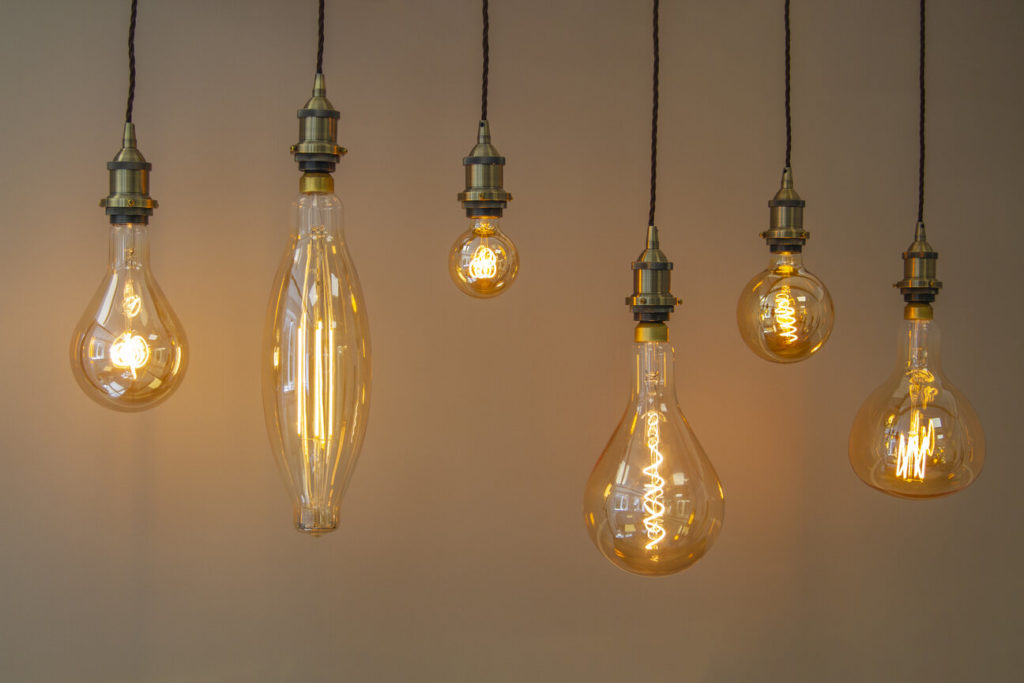
LED light bulbs have been a hot topic for many years now, and we hear a lot about energy efficiency. But are LED light bulbs safe?
LED light bulbs are a smart choice for your home lighting setup. They are much more energy efficient than their counterparts. They'll help to save money over time, and they are better for the environment too.
You might be keen to make that switch to LED bulbs if you are still using halogen bulbs (they have now been banned from sale in the UK). If you've never used LED bulbs before you might be wondering whether they are safe to use in your home.
LED Bulbs Components
A ban on fluorescent bulbs which are mostly used in offices will be banned in 2023. However, these bulbs contain small amounts of mercury. Because of this, these bulbs can't be chucked straight into the bin. They need to be disposed of in a safe way to avoid harming the environment.
LED bulbs do not contain mercury. While the internal components of LED bulbs can sometimes include harmful substances such as lead, they are not considered toxic to us.
As they contain such low levels of substances like this, they can be disposed of safely with your standard rubbish. The components used to make LED bulbs do not pose any risk to us, but if you were to smash one be sure to carefully dispose of it and use gloves when tidying up shattered pieces.
Eyestrain
There are growing concerns about the impact blue light has on eyes as some LED bulbs do emit blue light. Some lighting can also create a glare which can cause eye and head discomfort.
Research is still ongoing, but prolonged or excessive exposure to high-energy visible (HEV) blue light, especially for those under the age of 30, may eventually result in:
- Cataracts
- Age-related macular degeneration (AMD)
- Eyestrain
However, whilst some bulbs can emit blue light, it is mostly phone and tablet screens that emit this. Always opt for light bulbs from manufacturers using well-established safety practices.
At Elesi we are members of professional bodies such as the LIA (Lighting Industry Association). This means we conform to their rigorous manufacturing and testing standards on all of our lighting products.
Impact On Sleep Cycles
Blue light can also impact our sleep cycles. This is the reason that we are advised to come off our phones at least one hour before bed. This is because blue light suppresses the production of melanin, a chemical that helps us to sleep.
It can become a problem when we are exposed to blue or bright white lighting at times of the day when our body is getting ready to rest. This can be avoided by using cool white or bright white colour temperatures in rooms that are only used in the morning or afternoons, such as in a home office or garage.
Opt for warm bulbs or warm white bulbs in bedrooms and living rooms where you typically unwind and relax during the evenings.
Installing a dimmer switch with your lighting setup will give you further control over the brightness of lighting. You can then adjust it to suit your activities and the time of day, helping you to sleep better at night.
Dim to warm downlights are an excellent way to shift between cool tone and warm tone light. This makes dim to warm downlights perfect for multi-purpose rooms where task lighting is required for the morning, and rest in the evening.
LED light bulbs offer many benefits to your home and come with little drawbacks. They are safe to use but it's best to consider the right colour temperatures for your home and to install a dimmer switch to give you total control over your lighting setup, at any time of the day.
[related_products is_auto_added="1"]LED light bulbs have been a hot topic for many years now, and we hear a lot about their energy efficiency. But are LED light bulbs safe?
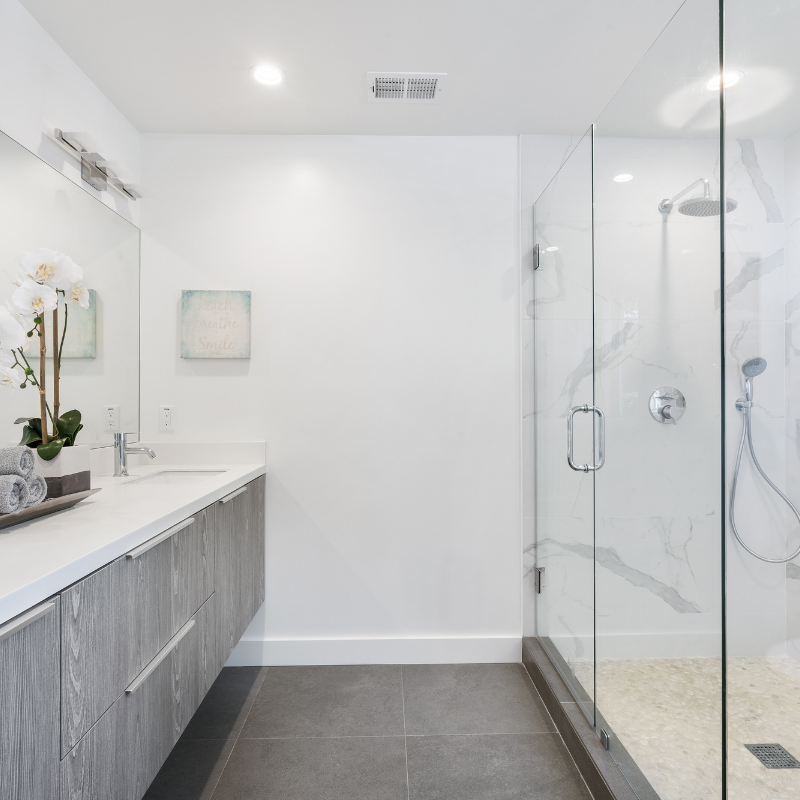
Downlights make a great choice for a bathroom. Suitably IP rated they can be placed within the wettest areas of a bathroom such as the shower. They are great for task lighting where greater clarity is needed such as for applying makeup and shaving. Installed on a dimmer switch, this greater flexibility allows you to control the ambience as the role of the room changes throughout the day.
Whether you're refitting a bathroom or in the process of a complete renovation, you might be wondering how many downlights are the right amount for a bathroom. We explore this commonly asked question.
How Many Downlights In The Bathroom?
There is no standard answer as each bathrooms size and location differs. But it's a good idea to follow a few rules which you can apply to any bathroom.
Firstly, consider where the mirror is placed in the bathroom. Never place downlights directly above the mirror as the light distribution can make you look tired. Instead, place a downlight above and next to the mirror on either side. This will ensure that the light is evenly distributed across your face.
The downlights will disperse ample light positioning them close to the mirror. Ensure the light is angled onto the mirror, helping to reflect the light onto your face. You'll need tilted downlights to achieve this.
Time to get more technical. A bathroom contains 3 zones, and you'll need IP65 rated downlights if installing directly over a bath or shower. To calculate the number of downlights required in a bathroom you'll need to;
- Measure the square footage of the room by multiplying its width by its depth.
- Multiply this square footage by 1.5. This will give you a guideline for the total wattage required to light the space.
- Choose the downlights you require for the bathroom. Then identify the wattage of the downlights and use the total wattage you just calculated divided by the wattage of these downlights to work out how many are required.
When choosing the placement of the downlights, ensure they are roughly 1.5 to 2 ft. away from walls with a space of 3 to 4 feet between each light.
What Downlights Should I Use In The Bathroom?
There are many different types of downlights you can use in a bathroom - colour temperatures, CRI, dimmable, fixed and tilted. The first thing to take into consideration is that the bathroom is one of the rooms that warrants greater flexibility. You might need bright, precision lighting in the morning for applying makeup etc, but in the evening you want it to be dimmable so you can relax in an ambient setting.
High CRI downlights are a great choice for any bathroom including those with no natural light. The highest CRI levels provide the truest representation of colour. Providing precision and greater clarity for any tasks such as shaving, or applying makeup. These are especially good for a bathroom with no natural light as it provides the closest thing to natural daylight.
Dimmable downlights will give you a much greater control over the lighting setup. Just ensure you install a compatible dimmer switch with them for them to effectively function.
Being able to adjust colour temperature of the downlights is not a necessity. But if you want greater control over the ambience in your room then these could be the perfect downlights for your bathroom. This will allow you to opt for a brighter, white colour temperature for tasks in the morning and switch to a warm, orangey colour temperature for a relaxing, ambient soak in the bath.
[related_products is_auto_added="1"]Whether you’re refitting or renovating a bathroom, you might be wondering how many downlights are the right amount for a bathroom. We explore this commonly asked question.
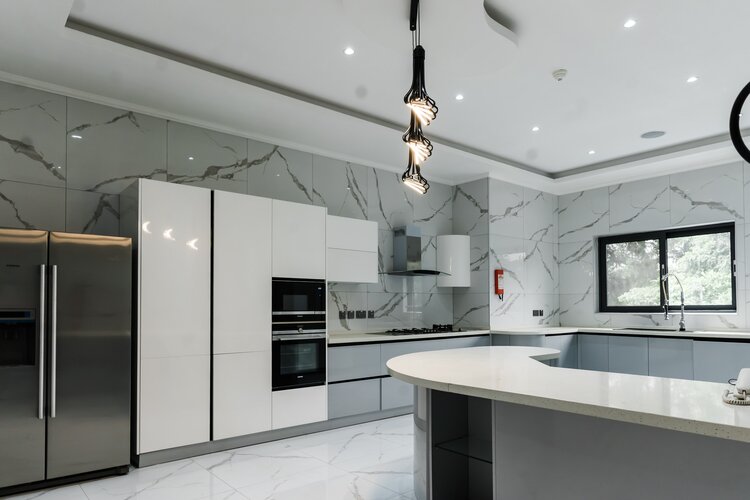
A contemporary living space is characterised by simplicity, clean lines and use of texture. The uncluttered yet homely design remains a popular decor choice for homes.
Whether you're looking to freshen up your existing home or are completely renovating a property, every little saving along the way helps! We explore contemporary living room ideas on a budget.
Clean Lines
Crisp and clean lines feature heavily throughout a contemporary home, providing cohesive structure to the space. Use sculptures, furniture, lighting and decorative accessories to run these clean lines throughout the home.
They don't just need to be clean cut lines, opt for curvaceous lines to soften the overall look too. You could use a curved kitchen island, or a curvaceous sofa set to provide diversity and command attention throughout the space. You don't need to break the bank to achieve this. See what items you already have available and pick out some key decorative pieces that provide those clean, structural lines.
Contemporary Furniture
No contemporary living room is complete without the furniture. When fitting out a room it's always best to start with the furniture which is the biggest asset, and focal point of a room.
One of the characteristic features of contemporary furniture is that the legs of sofas and armchairs are almost always exposed. Tapered, angled wooden legs are preferred over traditional turned ones on castor feet or those hidden under a skirt.
The fabric, material of the furniture is also an important consideration. Marble remains a popular feature in contemporary furniture thanks to those smooth, and ultra clean lines. Whilst colour shouldn't be shyed away from, neutral, muted tones are favoured throughout contemporary design. Furniture can be a big expense. So, do look at antique fairs, charity shops and Facebook marketplace to pick up a specific piece for less.
For a more affordable contemporary refresh, why not change the existing wooden knobs on your cabinets and pieces of furniture to something more contemporary? A quick refresh like this can transform a tired piece of furniture into something that looks amazing, and will last in your home for many years to come.
Texture
Contemporary homes demand texture throughout the space, creating a cosy, contrasting space. Even if you are pulled more towards the minimal aspects of this interior design style, you'll still need to build texture throughout the space.
This can easily be created in a living room which is naturally a place of cosiness and relaxation. Various layers of texture you can include are rugs, throws and cushions. Then put a focus on the type of material and don't be afraid to contrast. Use leather, fur and matte finishes to create visual interest in the room.
Contemporary Lighting
It's important to consider your lighting when creating a contemporary space. It should flow seamlessly from floor to ceiling. Recessed downlights are a very contemporary lighting choice for a living room, especially when combined with other layers of lighting. Opt for dimmable downlights so you can control the ambience of your room as role changes throughout the day.
To layer the lighting scheme, combine with sculptural wall lights or pendant lights to create that soft, yet contemporary feel.

Use Metal Finishes
Metal accents are warmly welcomed throughout a contemporary interior, but don't just keep it contained to your furniture. Metal interior hardware details such as sockets and switches and cabinetry handles will create a contemporary, yet subtle feel to the room. Try to keep to the same metal finish to avoid chaotic clashing.
Most metal finishes are well suited to a contemporary home and it is much down to personal preference, but the uncomplicated finish of both brushed chrome and polished chrome is perfect for a contemporary style.
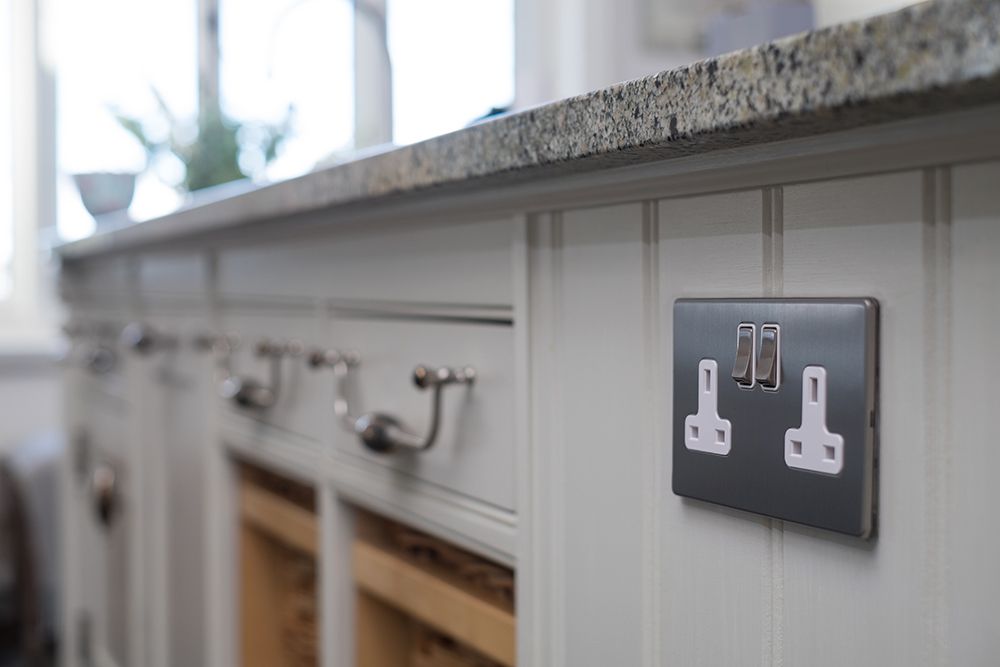
Use of Colour
Muted, neutral tones are favoured throughout this design style due to the uncomplicated nature of them. But don't make the mistake of thinking that bright white is the answer. It's certainly okay and acceptable to use contrasting colours as you may want to create specific focal points for a specific piece of furniture or design feature.
To create that confident contrast, a monochromatic colour scheme works incredibly well in a contemporary space. It allows you to move from one extreme to the next with precision.
There are plenty of ways to breathe a contemporary feel into your home without breaking the bank. Focus on the foundations of colour first before bringing in the other elements.
[related_products is_auto_added="1"]Whether you’re looking to freshen up your existing home or are completely renovating a property, we explore contemporary living room ideas on a budget.
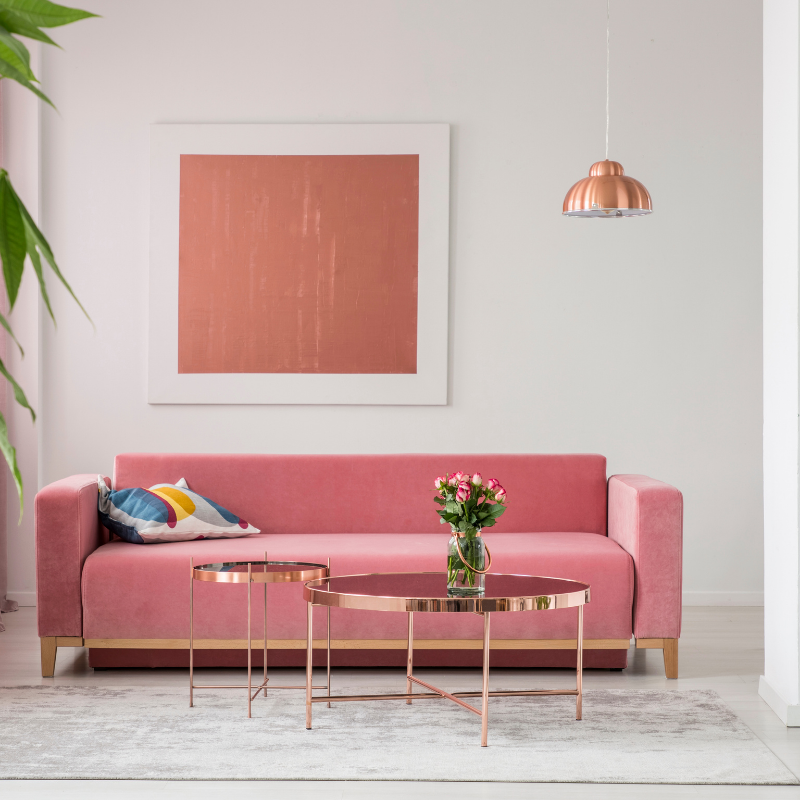
Pink is a colour that no longer needs to be shyed away from in interiors. Millennial or blush pink is one of the most popular pink hues, whilst it can stereotypically be referred to as a colour for girls, it's no longer just a shade for feminine inspired interiors.
If you're looking to bring this shade into your home, we take a look at the colours which go well with pink.
What Colours Go With Pink?
Pink And Grey
If you're using a softer pink such as dusty pink or blush in your interior, grey will complement it perfectly. This colour combination is soft, fresh and ultra modern.
If you're using pink on your walls, ground the lighter pink with darker accents of grey, and even black to prevent it from looking too feminine. If you're looking to create a feminine and delicate space then stick with a lighter shade of grey.
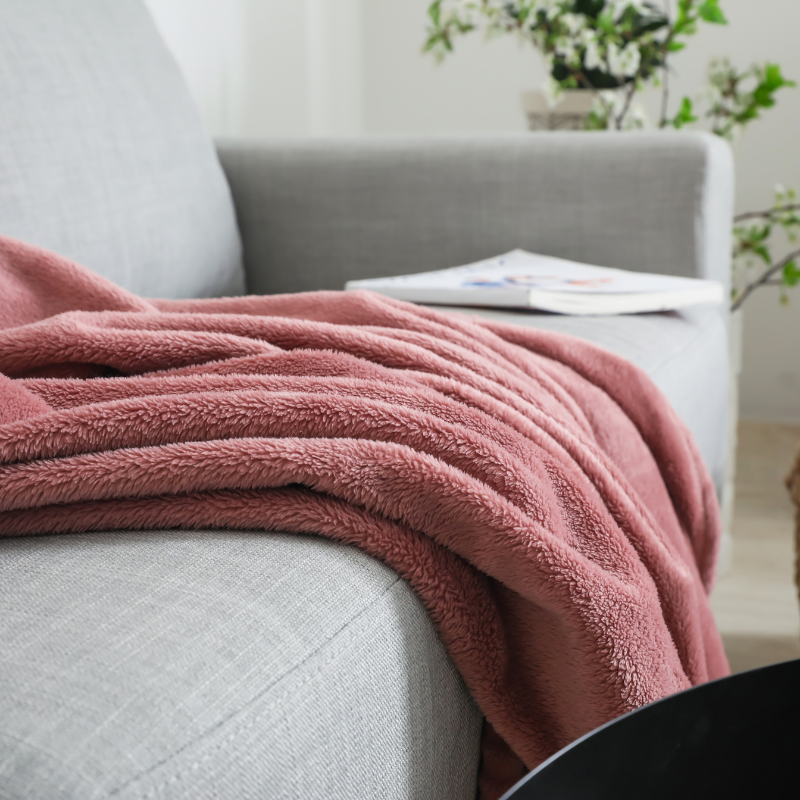
Pink & Olive Green
For a sophisticated and elegant look, pink and olive green work harmoniously together. Combine the two with furniture, throws and decorative accents. Treat either pink or olive green as the main focal colour to not overload the space. Then incorporate the second colour with gentle accents.
In fact, it's not just this shade of green that complements pink well. Any introduction of a subtle hint of green brings warmth to the space whilst contrasting well against the pink. Introduce greenery, fake plants and subtle decorative touches.
Pink & Red
Red is a similar colour to pink on the colour spectrum yet they can work well together when used in the right doses. As they are similar, too much of either colour will completely overpower the room. It's a good idea to introduce a third colour into the mix such as white or grey to use as the foundation colour.
Pink and red should be considered as complementary colours, use them sparingly in the space for throws, cushions, bedding and decorative accessories.
Pink & Blue
This makes for a colourful, and bold pairing that is incredibly effective in an interior. Opposites certainly do attract, with so many different shades of blue, you can create a different look and feel with each shade. Midnight blue creates an opulent look, whilst pastel blue and baby pink could suit a child's room or nursery.
You don't just have to create a bold and visual contrast with these colours. Create a calm and serene space with softer hues of pink and blue with white as a foundational base in the room.
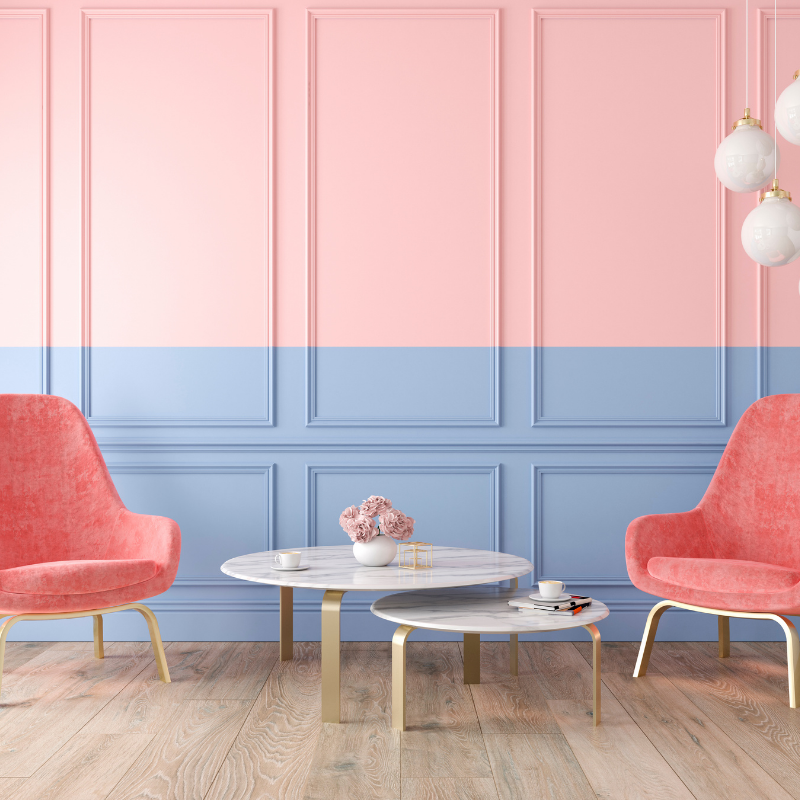
Pink & White
White provides a no nonsense, perfect base for pink and it's one of the most popular colour combinations. Whilst creating a bold contrast, it still helps to achieve a neutral base for pink. Incorporating grey for further warmth and visual interest.
White can be used throughout for the walls, whilst pink could be featured subtly through the furniture, decorative accessories and artwork without looking garish.
Pink And Copper
Copper is still very much the metal of the moment and pink and copper are the ultimate millennial crush. They complement each other so well due to the warmth that the copper provides. You often see pink furniture with copper frames, and used subtly as an accent colour.
Copper can look tacky if it's used too much, using it sparingly throughout a home can help to add those final finishing touches whilst enhancing the room around it. Copper sockets and switches add a perfect finishing touch, whilst a copper light might be all you need to add that gorgeous contrast against the pink.
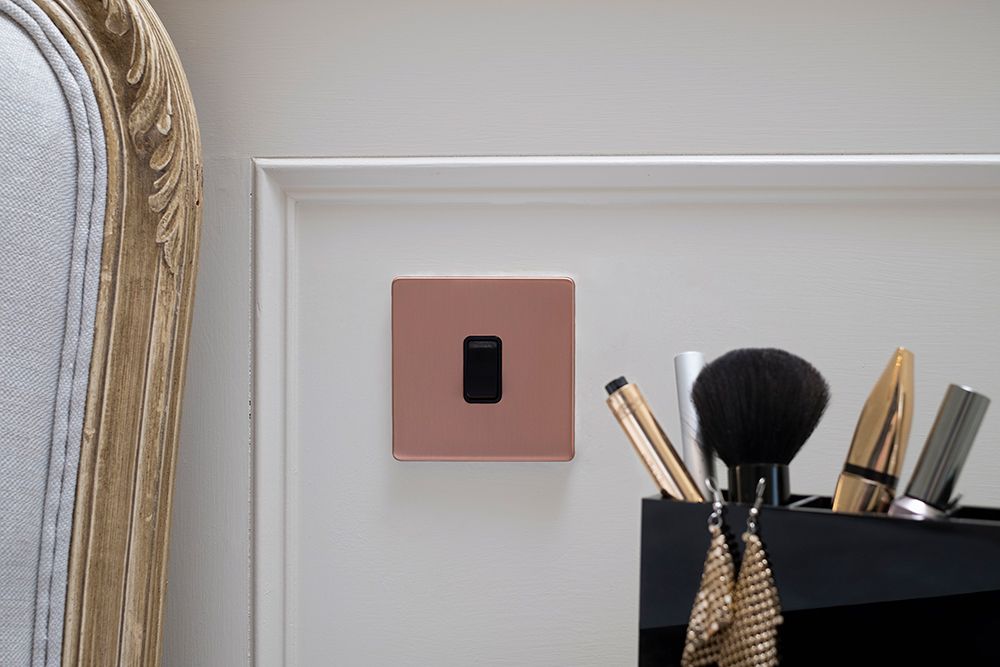
Pink is an incredibly versatile colour , available in a huge range of hues so you can find one that perfectly fits into your home. It can work in harmony with a range of colours to help create a balanced, and beautiful interior.
[related_products is_auto_added="1"]If you’re looking to bring this shade into your home, we take a look at the colours which go well with pink.
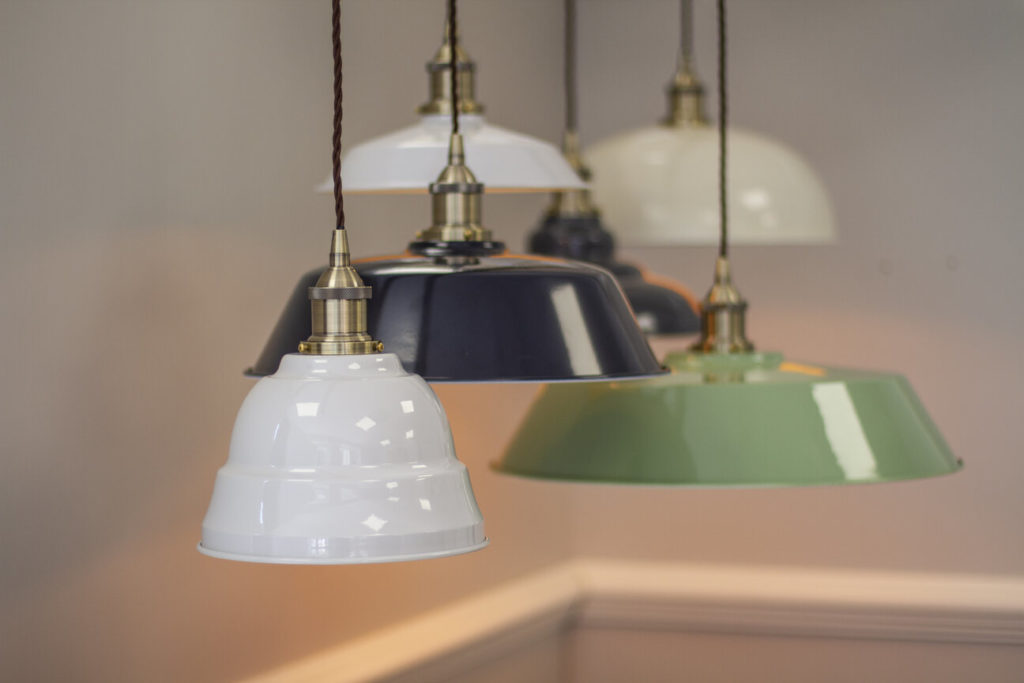
Simply adding a new light fitting to your home is considered to many as the 'lighting plan' for their home. But lighting design is science led and is the application of light to spaces. It is the foundations that will help that light create the desired look, and your home to flow throughout. You can't do one without the other.
Lighting design is all about how lighting can guide you through a home. Creating an effective lighting strategy, whilst formulas on the placement of the lights plays a huge role in pulling it together.
What Is Lighting Design?
Lighting design is the art of delivering effective light to spaces, and to pull you though a home. An ineffective lighting plan can impact satisfaction, visibility, task performance, mood and atmosphere. In addition to this, an effective lighting design will enhance your interior, helping it achieve its true potential.
It is also about understanding the needs of each room, what intensity of light is required in each room, does the role of the room change throughout the day? Is flexibility required in the lighting scheme? Is there a focal point of the room which needs illuminating. The answers to these questions will help to guide you with lighting design. This is when the real science, and art of lighting comes into play.
Lighting Design Formulas
There are various formulas that can be used to calculate lighting layout and the quantity of lights required per room for the best output and performance. This is an example calculation of lighting required in an office space. However it can be applied to any home, or commercial setting.
For example, for a dining room you will need the following input;
- The length, width and height of the room
- The dining table height
- What is the initial output of each LED lamp in lumens per watt
- The lamps maintenance factor, utilisation factor and space height ratio
The calculation then uses the input data in 8 different steps.
- Total wattage of fixtures
- Lumen per fixtures
- Number of fixtures
- Minimum spacing between each fixture
- Number of required rows of fixtures along with width of room
- Number of fixtures required in each row
- Axial spacing between each fixture
- Transverse spacing between each fixture
Lighting Placement
Perhaps one of the most common questions to do with lighting design is where should lights be placed, particularly in kitchens where recessed downlights are used. It's about the quantity and placement to ensure there is adequate lighting to aid food preparation, yet not too many lights so the room ends up over exposed. You need to take into consideration both the height and width of the room, how the room will be used and whether it is open plan.
To work out an approximate number of downlights required for a room you firstly need to work out the square footage of the space. You can measure the square footage of the space by multiplying its width by its depth. With this figure multiply it by 1.5, to give you a guideline of the total wattage to light the room.
The next step is to choose the bulbs and wattage that you want, then divide the total wattage figure just calculated by the bulb wattage that you want to use. This will then indicate the number of fixtures you require. This is only an approximate method of working out the optimum number of lights required, however an electrician or lighting design consultant can guide you further during the installation, as well as factoring in any other important considerations.
When using recessed downlights for task lighting in a kitchen it is recommended that over a countertop, the lights are fitted 24 inches out from the wall. The placement of this provides the optimum levels of light to aid tasks such as food preparation. Focus on the beam angle when purchasing your downlights so you know how far the light can spread.
Adding Flexibility To Lighting Design
Adding flexibility to your lighting scheme is key to controlling the ambience, and mood of your choice at the touch of a dimmer switch. Certain rooms require an ambient change throughout the day, such as a bathroom, kitchen or living room that needs to be brighter in the mornings but dimmer in the evening to create a relaxing, tranquil space.
Lighting is so much more than just brightening a space, it can help to set the mood, and enhance your mood. A dimmer switch is the easiest way to gain control over your lighting setup. Not every room necessarily needs a dimmer switch, but it's highly recommend to install one for rooms where the role changes throughout the day such as a kitchen and bathroom.
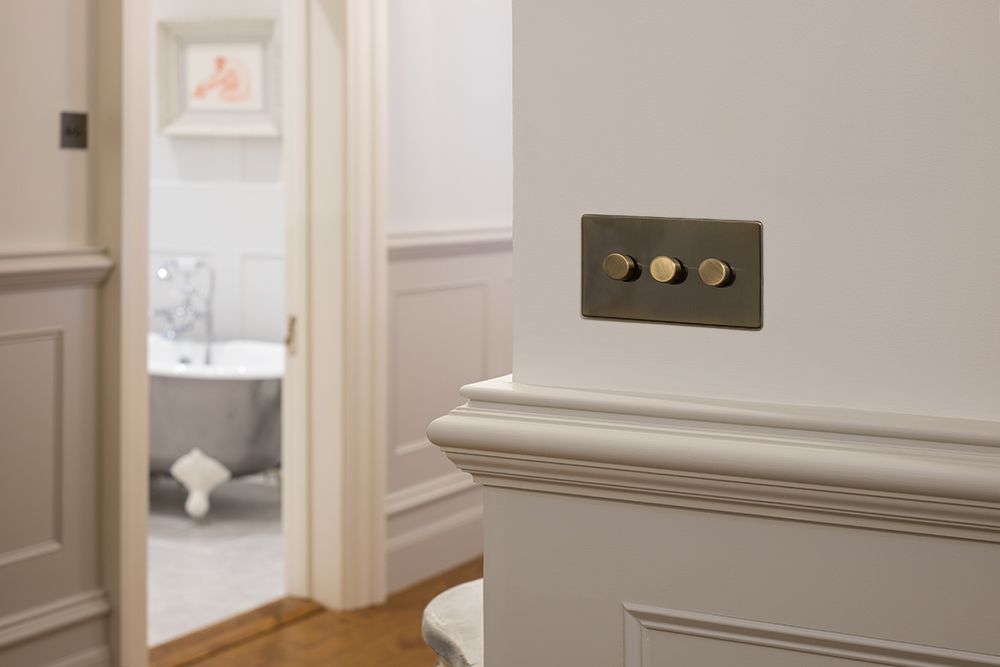
There are so many assets to lighting design to help enhance your home, and your experience within it. If you liked this article, you might also enjoy reading what is colour temperature - another incredibly important aspect of lighting design.
[related_products is_auto_added="1"]Lighting design is all about how lighting can guide you through a home, creating an effective lighting strategy to enhance your home.